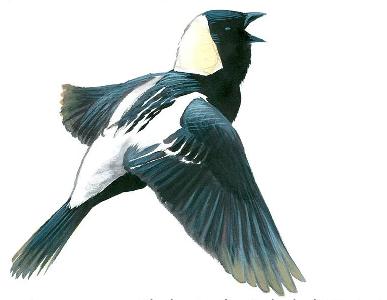|
What We Do
In case you’re new to The Bobolink Project, our strategy is simple.
We solicit donations from people interested in protecting Bobolinks and other grassland birds.
We also identify farmers who are similarly interested in conserving grassland birds on their farms. Those farmers face economic realities: if harvests are delayed to allow nesting birds to complete their breeding cycles, the resulting hay crop will be less valuable.
The Bobolink Project connects these two groups of people by using conservation donations to pay farmers to delay their harvests long enough that birds can complete their nesting—essentially renting a farmer’s field for about one month. Participating farmers are selected through an auction process in which low bids are prioritized, thereby guaranteeing that conservation dollars are used for their maximum benefit.
Read all about us >
What We Left on the Table
Another important aspect of this project concerns what we were unable to accomplish.
In 2016 we had to reject applications from 14 farmers who had submitted bids that exceeded what we were able to support from our donation pool. In other words, about 420 acres of offered habitat was lost because we needed more donations. And it is important to note that we did very little outreach looking for farms in 2016—the number of farms that would like to participate is likely much higher.
While it is wonderful of course that we succeeded in protecting 527 acres of grassland bird habitat, the fact that we had to “leave on the table” 420 acres that might have been protected is a sobering thought.
Remembering that more donations mean that more land can be protected from haying will hopefully stimulate many of you to continue to support the Project in 2017. Money donated now will be set aside toward the 2017 nesting season.
Contributions toward next year’s efforts can still be submitted now—even while the birds themselves are busily heading toward South America.

|
2016 Results

In the months leading up to the 2016 field season, we raised $42,000 was to support the Project’s objectives. Based on a fixed price, reverse auction, the final bid that was accepted was $75/acre.
With this financial support we were able to enroll about 513 acres distributed among 16 farms (13 located in Vermont, 2 in Massachusetts, and 1 in New York). We estimated that there were about 226 adult male Bobolinks on these farms. Counting breeding females and actual numbers of nests (a single male may have multiple mates) is difficult and very time-consuming, so we use the number of males as a "surrogate" of the potential number of young that may have been produced.
Using what we think is a conservative estimate of two fledglings per breeding male, we guess that 450 Bobolink young were produced as a result of the Project’s 2016 efforts.
Bobolink Project 2017
The principals in this partnership will all gather in Burlington, VT, on October 4. There we will discuss how this worked for out "parent" organizations, and how we can streamline delivery of this simple conservation tool.
There are several other states that want to participate, but we are trying to grow with the minimum of stress on our already "task-saturated" conservation parent groups. So expansion needs to be carefully considered.
We also know that farmers would like to be notified if their bids were accepted earlier in the year—so that means looking for donations sooner.
And while there are lots of other possible changes, we know one thing—this project helps farmers to help grassland birds. It is simple, and it is effective.
To get the latest information follow us on Facebook, check the website, and open (what we hope are) our rarely sent email newsletters.
And from those baby Bobolinks and their parents, we are authorized to say
Thank You.
|
